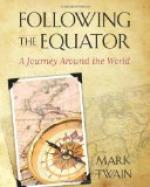These invitations were always for a long time ahead; if we were in Europe, three months ahead; if we were in America, six to twelve months ahead. They always named the exact date and train for the beginning and also for the end of the visit.
This first note invited us for a date three months in the future. It asked us to arrive by the 4.10 p.m. train from London, August 6th. The carriage would be waiting. The carriage would take us away seven days later-train specified. And there were these words: “Speak to Tom Hughes.”
I showed the note to the author of “Tom Brown at Rugby,” and be said: “Accept, and be thankful.”
He described Mr. Bascom as being a man of genius, a man of fine attainments, a choice man in every way, a rare and beautiful character. He said that Bascom Hall was a particularly fine example of the stately manorial mansion of Elizabeth’s days, and that it was a house worth going a long way to see—like Knowle; that Mr. B. was of a social disposition; liked the company of agreeable people, and always had samples of the sort coming and going.
We paid the visit. We paid others, in later years—the last one in 1879. Soon after that Mr. Bascom started on a voyage around the world in a steam yacht—a long and leisurely trip, for he was making collections, in all lands, of birds, butterflies, and such things.
The day that President Garfield was shot by the assassin Guiteau, we were at a little watering place on Long Island Sound; and in the mail matter of that day came a letter with the Melbourne post-mark on it. It was for my wife, but I recognized Mr. Bascom’s handwriting on the envelope, and opened it. It was the usual note—as to paucity of lines—and was written on the customary strip of paper; but there was nothing usual about the contents. The note informed my wife that if it would be any assuagement of her grief to know that her husband’s lecture-tour in Australia was a satisfactory venture from the beginning to the end, he, the writer, could testify that such was the case; also, that her husband’s untimely death had been mourned by all classes, as she would already know by the press telegrams, long before the reception of this note; that the funeral was attended by the officials of the colonial and city governments; and that while he, the writer, her friend and mine, had not reached Melbourne in time to see the body, he had at least had the sad privilege of acting as one of the pall-bearers. Signed, “Henry Bascom.”
My first thought was, why didn’t he have the coffin opened? He would have seen that the corpse was an imposter, and he could have gone right ahead and dried up the most of those tears, and comforted those sorrowing governments, and sold the remains and sent me the money.




